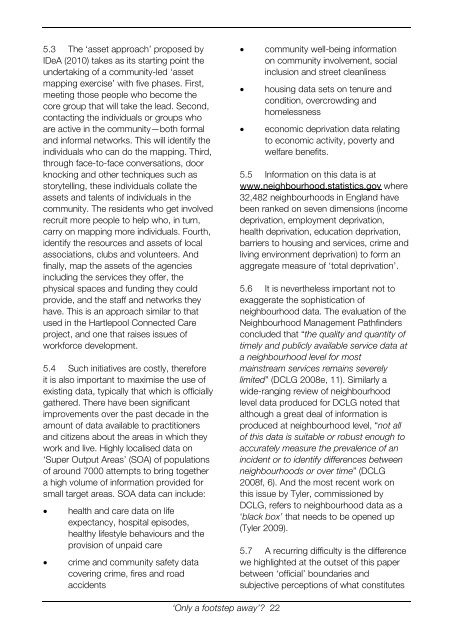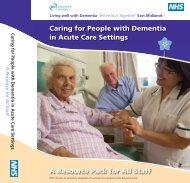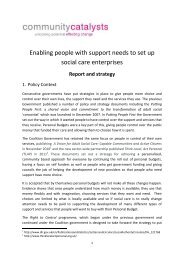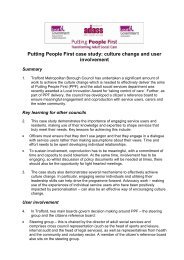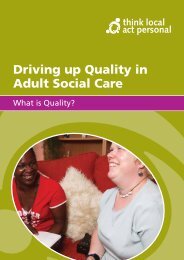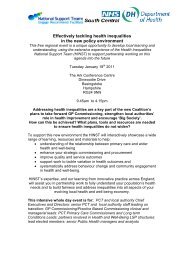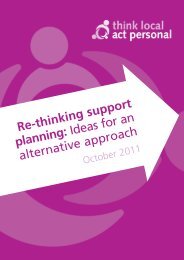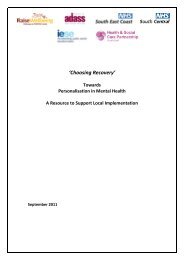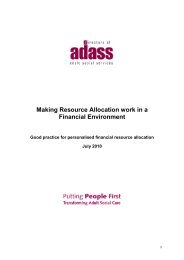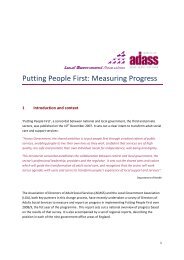'Only a footstep away' - Skills for Care - Think Local Act Personal
'Only a footstep away' - Skills for Care - Think Local Act Personal
'Only a footstep away' - Skills for Care - Think Local Act Personal
- No tags were found...
You also want an ePaper? Increase the reach of your titles
YUMPU automatically turns print PDFs into web optimized ePapers that Google loves.
5.3 The ‘asset approach’ proposed byIDeA (2010) takes as its starting point theundertaking of a community-led ‘assetmapping exercise’ with five phases. First,meeting those people who become thecore group that will take the lead. Second,contacting the individuals or groups whoare active in the community—both <strong>for</strong>maland in<strong>for</strong>mal networks. This will identify theindividuals who can do the mapping. Third,through face-to-face conversations, doorknocking and other techniques such asstorytelling, these individuals collate theassets and talents of individuals in thecommunity. The residents who get involvedrecruit more people to help who, in turn,carry on mapping more individuals. Fourth,identify the resources and assets of localassociations, clubs and volunteers. Andfinally, map the assets of the agenciesincluding the services they offer, thephysical spaces and funding they couldprovide, and the staff and networks theyhave. This is an approach similar to thatused in the Hartlepool Connected <strong>Care</strong>project, and one that raises issues ofwork<strong>for</strong>ce development.5.4 Such initiatives are costly, there<strong>for</strong>eit is also important to maximise the use ofexisting data, typically that which is officiallygathered. There have been significantimprovements over the past decade in theamount of data available to practitionersand citizens about the areas in which theywork and live. Highly localised data on‘Super Output Areas’ (SOA) of populationsof around 7000 attempts to bring togethera high volume of in<strong>for</strong>mation provided <strong>for</strong>small target areas. SOA data can include:• health and care data on lifeexpectancy, hospital episodes,healthy lifestyle behaviours and theprovision of unpaid care• crime and community safety datacovering crime, fires and roadaccidents• community well-being in<strong>for</strong>mationon community involvement, socialinclusion and street cleanliness• housing data sets on tenure andcondition, overcrowding andhomelessness• economic deprivation data relatingto economic activity, poverty andwelfare benefits.5.5 In<strong>for</strong>mation on this data is atwww.neighbourhood.statistics.gov where32,482 neighbourhoods in England havebeen ranked on seven dimensions (incomedeprivation, employment deprivation,health deprivation, education deprivation,barriers to housing and services, crime andliving environment deprivation) to <strong>for</strong>m anaggregate measure of ‘total deprivation’.5.6 It is nevertheless important not toexaggerate the sophistication ofneighbourhood data. The evaluation of theNeighbourhood Management Pathfindersconcluded that “the quality and quantity oftimely and publicly available service data ata neighbourhood level <strong>for</strong> mostmainstream services remains severelylimited” (DCLG 2008e, 11). Similarly awide-ranging review of neighbourhoodlevel data produced <strong>for</strong> DCLG noted thatalthough a great deal of in<strong>for</strong>mation isproduced at neighbourhood level, “not allof this data is suitable or robust enough toaccurately measure the prevalence of anincident or to identify differences betweenneighbourhoods or over time” (DCLG2008f, 6). And the most recent work onthis issue by Tyler, commissioned byDCLG, refers to neighbourhood data as a‘black box’ that needs to be opened up(Tyler 2009).5.7 A recurring difficulty is the differencewe highlighted at the outset of this paperbetween ‘official’ boundaries andsubjective perceptions of what constitutes‘Only a <strong>footstep</strong> away’? 22


